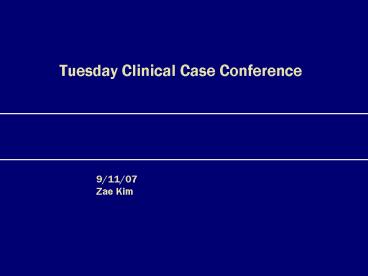Tuesday Clinical Case Conference - PowerPoint PPT Presentation
1 / 40
Title:
Tuesday Clinical Case Conference
Description:
Tuesday Clinical Case Conference. 9/11/07. Zae Kim. Atheroembolic disease ... Fat droplet absorption. Cytokine release. Inflammation. Monocyte- macrophage ... – PowerPoint PPT presentation
Number of Views:150
Avg rating:3.0/5.0
Title: Tuesday Clinical Case Conference
1
Tuesday Clinical Case Conference
9/11/07 Zae Kim
2
Atheroembolic disease (Cholesterol Crystal
Embolism)
- Epidemiology
- Clinical and pathologic findings
- Diagnosis
- Pathogenesis
- Treatment
3
Atheroembolic Renal Disease (AERD)
- An underdiagnosed and increasing cause of renal
failure - Caused by showers of cholesterol crystals from an
atherosclerotic aorta that occlude small renal
arteries - Often multisystemic
- Iatrogenic complication
- Treatment?
4
Epidemiologyretrospective autopsy
studyantemortem biopsy study
5
Incidenceretrospective autopsy studies
6
Incidence antemortem biopsy studies
7
Incidence
8
Risk factors
9
Risk factors
10
Risk factors
11
Risk factors
12
Risk factors
- Age gt60
- Male gender
- White
- HTN
- Tobacco use
- DM
- Atherosclerosis
- CAD
- AAA
- PVD
13
Clinical and laboratory presentation
14
Clinical Features
- Atheroembolic renal disease is part of a
multisystem - Renal
- 50 patients affected
- Multiple presentation
- Acute
- Subacute
- Chronic
15
Clinical Presentation
16
(No Transcript)
17
Clinical and Laboratory Presentation
18
GI
Gastric mucosal and submucosal biopsy -cholesterol
crystals in the submucosal arterioles
19
Clinical and Laboratory Presentation
20
Cholesterol crystals lodged in the retinal
vessels (Hollenhorst plaques) on funduscopic
examination.
21
outcome
22
outcome
23
Survival rate (Kaplan Meier) of 67 patients with
disseminated CCE
24
Laboratory Features
- Variable and NONE ARE PATHOGNOMIC
- Serum chemistry
- Elevated BUN, creatinine
- amylase, CPK, LFTs
- Hematology
- leukocytosis, thrombocytopenia, and eosinophilia
- Elevated ESR, CRP
- Serologic
- Elevated ESR
- Decreased serum complement
- Urine (abnormal but nonspecific)
- proteinuria, hematuria, eosinophilia
25
Pathogenesis
- Flory (1945)
- 267 consecutive autopsies
- 9 cases of cholesterol crystal embolism
- 2/147 (1) with moderate aortic plaque erosion
- 7/57 (12) with severe aortic plaque erosion
- 0 in 63 cases with absence of aortic plaque
ulceration
http//www.mdconsult.com/das/book/body/77638334-4/
620123283/1201/I4-u1.0-B0-7216-0164-2..50036-7--f1
0.fig?tocnode50835407
26
Atheroma
- How vulnerable plaque is formed
- Fat droplet absorption
- Cytokine release
- Inflammation
- Monocyte-gtmacrophage
- Further fat collection
- The fat-filled cells form a plaque with a thin
covering.
http//heart.health.ivillage.com/cholesterol/heart
attack3.cfm
27
Pathology
- CCE lodge in multiple small arteries (150-200 µm
in diameter) - Interlobular, afferent arterioles, terminal
arterioles, and glomerular capillaries
Thin section, toluidine blue stain shows the
characteristic cholesterol clefts (due to washout
of the cholesterol crystals during histologic
processing) of an atheroembolus in the small
renal artery
28
Histologic features
- In acute lesion
- Occlusion of lumen of small vessel
- Inflammatory response PMN leukocytes and
eosinophils - Later stage
- Foreign-body giant cells
- Endothelial proliferation
- Fibrous tissue surrounding the crystals
29
Diagnosis
- great masquerader
- CCE is ubiquitous with random and variable
distributions in the body - Mimic many other clinical syndromes
- Ddx
- Vasculitis
- Subacute endocarditis
- Polymyositis
- Myoglobinuric renal failure
- Drug-induced interstitial nephritis
- Renal artery thrombosis or thromboembolism
30
Definitive diagnosis - biopsy
- Biopsy
- Characteristic needle-shaped empty clefts within
arterioles - ghost cells because crystals are dissolved
during tissue fixation - Muscle, kidney, or skin
- Cutaneous biopsy with 92 yield
31
Treatment
- No effective treatment available
- Secondary Prevention
- Avoid precipitating factors
- aggressive risk factor modification, and
- optimal medical mgmt of CVD
- smoking cessation, anti-platelet tx, and bp
control, cholesterol and glucose - Statin uncertain?
- Steroid?
- Surgical with clear embolic source
32
What is the implication of eosinophilia/-uria and
hypocomplementemia?
33
Eosinophilia
Eosinophiluria
34
Hypocomplementemia
- Complement and inflammatory response may play a
role in pathogenesis of AERD. - Hammerschmidt (J lab Clin med 1981)
35
Generation of PMN-aggregating activity in plasma
incubated with lipids extracted from atheromatous
aortas
Aggregating activity of PMN
36
Role of steroid?
- Use of corticosteroid was associated with 100
mortality (Fine, Agiology, 1987) - Belenfants experience (1999)
- N18
- Patients with laboratory evidence of inflammation
- Corticosteroid treatment using prednisolone
0.3mg/kg - Outcome
- Therapy credited with the relief of lower limb
and/or gastrointestinal pain and definite
improvement in food intake and clinical status
37
conclusion
- Under-recognized cause of kidney failure
- Think about it before precipitating risk
- Think about it in your differential
- Look for it
38
Belenfant Supportive treatment improves survival
in multivisceral cholesterol crystal embolism. Am
J Kidney Dis 1999, 33840-850.
- Highlighted the potential benefits of avoiding
further precipitating insults in conjunction with
optmal medical management
39
Belenfant
- Larges series to date, n67, w catastrophic
atheroembolism - Prospective with f/u to 4 yrs
- N2102 admit to renal intensive care unit over
11-yr period - Dx
- Based on clinical and histologic findings
- Excluded patients with other causes of acute or
acute on chronic renal impairment (also excluded
CIN or perioperative associated renal failure)
40
The end































